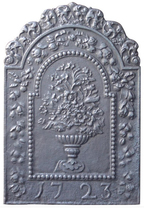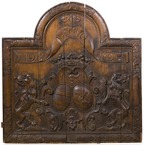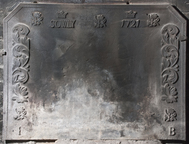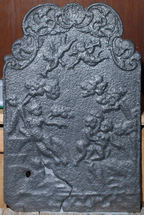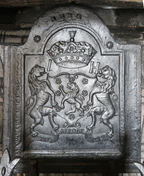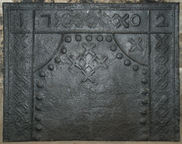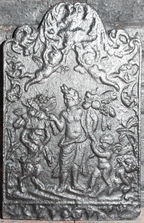-
1133
Description: Arched rectangular central panel with bead on fillet edging; flowers in a gadrooned vase upon a pedestal; arched rectangular border with fillet edging containing flowers descending from a ribbon bow; at the bottom, date; on top, symmetrical swirled foliage.
Notes: The swirled foliage on top and the proportions of the fireback suggest an English origin.
Inscription: 1723
- Decoration tags:
- whole carved pattern
- text
- plants
- objects
Manufactured: in 1723 in England.
Current location: not known.
- Attached to series:
- British 'Dutch' style firebacks
-
1139
Description: Carved wooden fireback pattern. Arched rectangular shape; fillet edging to a rounded frame with sections of acanthus leaves at the corners and at the top of the arch, and blank campartments in between; astragal and fillet inside edging; arched rectangular inscription scroll suspended with faux ribbon from the top of the arch; below, a coronet over a large baroque cartouche containg two oval shields: Massenbach - azure two bars or, d'Helmstadt - argent a crow sable; on either side, lion rampant reguardant supporters; four vertical planklines.
Notes: A finely executed carving. Nicolas de Massenbach (1659-1722) and Francoise d'Helmstadt (d.1729) were married at Ourches-sur-Meuse, in Lorraine, in 1695.
Inscription: NDM 1710 FDH
Arms: Nicolas de Massenbach and Francoise d'Helmstadt
- Decoration tags:
- rectangular with round arch (shape)
- fillet (edging)
- whole carved pattern
- planklines
- heraldic
- armorial
- text
Manufactured: in 1710 in France.
Current location: not known.
Citation: Palasi, P., 2014, Plaques de Cheminées Héraldiques (Paris, Éditions Gourcuff-Gradenigo).
- Attached to series:
- Patterns
-
1056
Description: Canted rectangle; moulded fillet edging (top and sides); top line, 'daisy' plant stamp repeated three times, spaced evenly, with 'SOWLY' in a block, a ducal coronet above, between the left two, and '1721' in individual numerals, a ducal coronet above, between the right two; a swirling foliage stamp repeated down each side, a 'daisy' plant below each; initials 'I' and 'B' separately in bottom corners.
Notes: Sowley was the iron furnace in Hampshire owned in 1721 by the 2nd duke of Montagu, whose coronet is seen in the decoration, and operated by John White of Monmouth. The swirled foliage stamp is seen on other firebacks identified by the letters 'IB' between 1703 and 1721, probably indicating the same founder.
Inscription: SOWLY 1721 / I B
- Decoration tags:
- rectangular with canted top corners (shape)
- moulded fillet (edging)
- carved stamps
- individual numbers
- heraldic
- text
- plants
Manufactured: in 1721 at Sowley Furnace, Beaulieu in the New Forest area of England.
Current location: Palace House, Beaulieu, Hampshire, England.
- Attached to series:
- IB series
-
1057
Description: Rectangular; moulded fillet edging (top and sides); left justified text in upper case, in two lines: Tunc bonus est ignis cum pendet stiria tignis (Then fire is good when icicles hang from the eaves); below left, 'SOWLY' in a block; below right, '1721' in individual numerals; a swirling foliage stamp repeated down each side; initials 'I' and 'B' separately in bottom corners.
Notes: The source of the inscription is 'A Dictionarie in English and Latine for Children' by William Clark (London, Thomas Purfoot, 1602), p. 13. Sowley was the iron furnace in Hampshire owned in 1721 by the 2nd duke of Montagu and operated by John White of Monmouth. The swirled foliage stamp is seen on other firebacks identified by the letters 'IB' between 1703 and 1721, probably indicating the same founder.
Inscription: TUNC BONUS EST IGNIS / CUM PENDET STIRIA TIGNIS / SOWLY 1721 / I B
- Decoration tags:
- rectangular (shape)
- moulded fillet (edging)
- carved stamps
- individual numbers
- heraldic
- text
- plants
Manufactured: in 1721 at Sowley Furnace, Beaulieu in the New Forest area of England.
Current location: Palace House, Beaulieu, Hampshire, England.
- Attached to series:
- IB series
-
1209
Description: Individually designed quasi-arched rectangular shape; astragal edging; central portico with framed doorway and sloping roof, in which stands a male figure dressed in contemporary style; above the roof, the date, and above that, the initials R R separated by a flower head, this inscription enclosed within a five-sided ribbon compartment held at the top corners by a pair of mirrored dancing cherubs each of which holds in their outer hand a wand surmounted by a fleur-de-lys; below them are mirrored vine designs terminating in a grape bunch, and below each of them a mirrored swirled snake, its head reversed; towards the outer side of these snakes are a pair of mirrored birds within a curved cartouche of slightly raised relief that is associated with a swirl on each side of the fireback that terminates the astragal edging on each side and which ascends via a step surmounted by a miniature urn on each shoulder of the back to the top which is surmounted by an acorn shape; above the ribbons held by the cherubs, is a stylised crown between the initials GR; the above features are limited by a horizontal astragal, though the portico descends below it, and which is supported at each end by a simple Doric column enclosing the bottom panel which is otherwise plain.
Notes: The initials GR are of Georgius Rex - King George I. Finely cast but of naïve design, another fireback of the same design but with different inscriptions and dated 1714 is at Low Graythwaite in Hawkshead parish, which was home to the Rawlinson family who, in 1711, built the first blast furnace in what was then the northern part of Lancashire.
Inscription: G R / R R / 1723
- Decoration tags:
- rectangular with round arch (shape)
- astragal (edging)
- whole carved pattern
- individual letters
- individual numbers
- heraldic
- mythological
- text
- humans
- plants
Manufactured: in 1723 possibly at Backbarrow Furnace in the Furness area of England.
Current location: Blackwell House, Bowness-on-Windermere, Cumbria, England.
- Attached to series:
- Rawlinson series
-
214
Description: Rectangular with arched, mirrored scrolls on top and central scallop shell; fillet edging; in a grove with two putti above, blowing trumpets, to the left, a naked female figure seated against a table, pointing at three children to the right, on a rock; at the bottom, narrow panel with indistinct decoration.
Notes: The scene is probably from classical mythology, but has not been identified.
Copies of this fireback are known.
- Decoration tags:
- rectangular with ornate arch (shape)
- fillet (edging)
- whole carved pattern
- pictorial
- mythological
- humans
- plants
Manufactured: in the early-18th century in England.
Current location: Brighton Museum and Art Gallery, Brighton, East Sussex, England.
Museum number: HATMP002269 (part of the Brighton Museum museum group)
- Attached to series:
- Late pictorial series (all)
- Late pictorial series 2
-
972
Description: Arched rectangular shape with ovolo-moulded edging and extensions to sides and top; central shield bearing arms with lion rampant supporters and motto scroll beneath; above, a marquesal coronet; date (over-pressed) in extension above main panel; inserted initials (slightly over-pressed) on either side of coronet.
Notes: The arms are of Henry Pierrepont, marquess of Dorchester and earl of Kingston-upon-Hull, of Thoresby Hall, Nottinghamshire (blazon: argent semi of cinquefoils gules, a lion rampant sable), with the motto: Pie Repone Te (Place yourself piously), a pun on the name, Pierrepont. Confusingly, the marquisate of Dorchester was created twice for members of the same family. In 1645 it was created for Henry Pierrepont, 2nd earl of Kingston-upon-Hull, becoming extinct on his death without surviving male issue in 1680. It was created again for Evelyn Pierrepont, the 5th earl of Kingston in 1706 who was subsequently elevated to the dukedom of Kingston in 1715. The original casting may therefore have dated to between 1645 and 1680 or between 1706 and 1715. The initials may be related to the Halls, the 2nd Duke of Kingston's mother's family, and were added to a subsequent casting which, in turn, could have pre-dated the addition of the dated extensions which have obliterated 'Dutch'-style dolphins known to have surmounted the original.
Inscription: 1722 / I H / PIE REPONE TE
Arms: Pierrepont, Marquess of Dorchester
- Decoration tags:
- rectangular with round arch (shape)
- ovolo (edging)
- whole carved pattern
- extension panels
- armorial
- text
Manufactured: in 1722 in England.
Current location: Red Lodge, Park Row, Bristol, England.
Museum number: NX420 (part of the Bristol Museums, Galleries and Archives museum group)
- Attached to series:
- Personal armorial firebacks
- Pierrepont series
-
1022
Description: Rectangular, with double fillet edging (top and sides); fillets parallel to top and to each side, dividing the plate into two square corner panels and narrow rectangular panels along top and down each side; fillet arc across inside top corners; date split between top corners, divided by vertical fillets, and separated by a hollow saltire stamp repeated six times; one hollow saltire, with a central bead, between each corner arc; eight similar saltire stamps down each side panel; 27 'daisy heads' arranged regularly around outer edge of central panel, with five saltires arranged in a cross shape in the centre.
Notes: The arc shape and use of repeated 'daisy heads' suggests a common source with other firebacks of the same period; the poor definition is due to insufficient impression at the moulding stage.
Inscription: 17 02
- Decoration tags:
- rectangular (shape)
- fillet (edging)
- carved stamps
- individual numbers
Manufactured: in 1702 in the Forest of Dean area of England.
Current location: Tolsey Museum, 126 High Street, Burford, Oxfordshire, England.
(part of the Tolsey Museum, Burford museum group)
- Attached to series:
- Hollow saltire series
- Newent area group
-
25
Description: Quasi-arched rectangular shape with arch decorated with floral swirls and an urn on each shoulder; three female figures: Aphrodite on the left, Hera in the centre on a plinth with two peacocks behind her, and Athena on the right; a double tassel hangs above Hera’s head.
Notes: The figures are the participants in the Judgement of Paris, the outcome of which precipitated the Trojan War.
Copies of this fireback are known.
- Decoration tags:
- rectangular with ornate arch (shape)
- fillet (edging)
- whole carved pattern
- pictorial
- mythological
- humans
Manufactured: in the early-18th century in England.
Current location: Bateman's, Burwash, East Sussex, England.
Museum number: 761070 (part of the National Trust museum group)
- Attached to series:
- Late pictorial series (all)
- Late pictorial series 4
-
26
Description: Quasi-arched rectangular shape with swirled and draped foliage across the top; fillet edging with bottom panel containing indistinct floral scrolls; figure of Plenty/Abundance holding a bunch of fruit, accompanied on her left by a cherub, and receiving a further bunch of fruit from a faun to her right; two cherubs hold foliage aloft.
Notes: The figure of Plenty is one of the representations in the Iconologia, published in the early 17th century by Cesare Ripa, and subsequently in other editions. They frequently form the subject of firebacks.
Copies of this fireback are known.
- Decoration tags:
- rectangular with round arch (shape)
- fillet (edging)
- whole carved pattern
- pictorial
- allegorical
- humans
Manufactured: in the early-18th century in England.
Current location: Bateman's, Burwash, East Sussex, England.
Museum number: 761087 (part of the National Trust museum group)
- Attached to series:
- Late pictorial series (all)
